"Whinny Moor" 'whin' is the Northumbrian word for gorse, or furze.
"This ae neet -" From the Cleveland Lyke Wake Dirge.. 'Lyke Wake' means 'corpse vigil' and the origins of this strange song are very ancient indeed.. There is a deep paganism in the stark, fiery imagery which suggests a belief in the transmigration of dead mens souls across the moors to the sea and judgement. The church 'lych gate' (where the coffin was placed before interment) is also derived from the same linguistic root - the german 'leich'- a corpse.
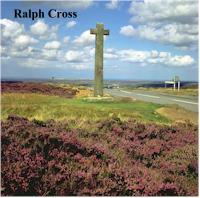
"The old jet miner's track" jet, along with ironstone, alum and mica has long been extracted from the Cleveland Hills and the North Yorkshire Moors. Indeed, the Coast -to-Coast route follows part of the Rosedale Ironstone Railway, the tracks of which were taken up long ago, leaving a lonely embankment in the midst of desolate moors.Old wayside crosses like Ralph Cross and White Cross (Fat Betty!) Also mark the direction of ancient moorland ways.
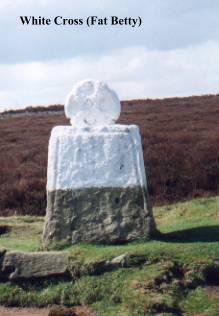
"The Handstone" Stands near the Facestone on Urra Moor, just beyond Clay Bank Top.
"The Stony Howe" "Howe" is the local name for a tumulus, or bronze age burial mound. These are to be found in great numbers on the rolling plateaux of the North Yorkshire Moors. They dot every horizon and make distinctive landmarks for the walker in an otherwise featureless wilderness. Everywhere there are traces of mysterious and forgotten peoples.
"The Smuggler's Trod" smuggling was a highly profitable business in these parts in days gone by. The proximity of wild and lonely moors to a stern and cliff girt coastline, dotted with tiny coves made this an ideal location for the smuggling of illegal goods. "Watch the wall my darling, while the gentlemen go by…!"
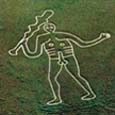

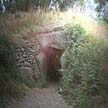
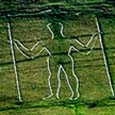
"This ae neet -" From the Cleveland Lyke Wake Dirge.. 'Lyke Wake' means 'corpse vigil' and the origins of this strange song are very ancient indeed.. There is a deep paganism in the stark, fiery imagery which suggests a belief in the transmigration of dead mens souls across the moors to the sea and judgement. The church 'lych gate' (where the coffin was placed before interment) is also derived from the same linguistic root - the german 'leich'- a corpse.

"The old jet miner's track" jet, along with ironstone, alum and mica has long been extracted from the Cleveland Hills and the North Yorkshire Moors. Indeed, the Coast -to-Coast route follows part of the Rosedale Ironstone Railway, the tracks of which were taken up long ago, leaving a lonely embankment in the midst of desolate moors.Old wayside crosses like Ralph Cross and White Cross (Fat Betty!) Also mark the direction of ancient moorland ways.

"The Handstone" Stands near the Facestone on Urra Moor, just beyond Clay Bank Top.
"The Stony Howe" "Howe" is the local name for a tumulus, or bronze age burial mound. These are to be found in great numbers on the rolling plateaux of the North Yorkshire Moors. They dot every horizon and make distinctive landmarks for the walker in an otherwise featureless wilderness. Everywhere there are traces of mysterious and forgotten peoples.
"The Smuggler's Trod" smuggling was a highly profitable business in these parts in days gone by. The proximity of wild and lonely moors to a stern and cliff girt coastline, dotted with tiny coves made this an ideal location for the smuggling of illegal goods. "Watch the wall my darling, while the gentlemen go by…!"





"The Handstone" Stands near the Facestone on Urra Moor, just beyond Clay Bank Top.
"The Stony Howe" "Howe" is the local name for a tumulus, or bronze age burial mound. These are to be found in great numbers on the rolling plateaux of the North Yorkshire Moors. They dot every horizon and make distinctive landmarks for the walker in an otherwise featureless wilderness. Everywhere there are traces of mysterious and forgotten peoples.
"The Smuggler's Trod" smuggling was a highly profitable business in these parts in days gone by. The proximity of wild and lonely moors to a stern and cliff girt coastline, dotted with tiny coves made this an ideal location for the smuggling of illegal goods. "Watch the wall my darling, while the gentlemen go by…!"




"The Handstone" Stands near the Facestone on Urra Moor, just beyond Clay Bank Top.
"The Stony Howe" "Howe" is the local name for a tumulus, or bronze age burial mound. These are to be found in great numbers on the rolling plateaux of the North Yorkshire Moors. They dot every horizon and make distinctive landmarks for the walker in an otherwise featureless wilderness. Everywhere there are traces of mysterious and forgotten peoples.
"The Smuggler's Trod" smuggling was a highly profitable business in these parts in days gone by. The proximity of wild and lonely moors to a stern and cliff girt coastline, dotted with tiny coves made this an ideal location for the smuggling of illegal goods. "Watch the wall my darling, while the gentlemen go by…!"